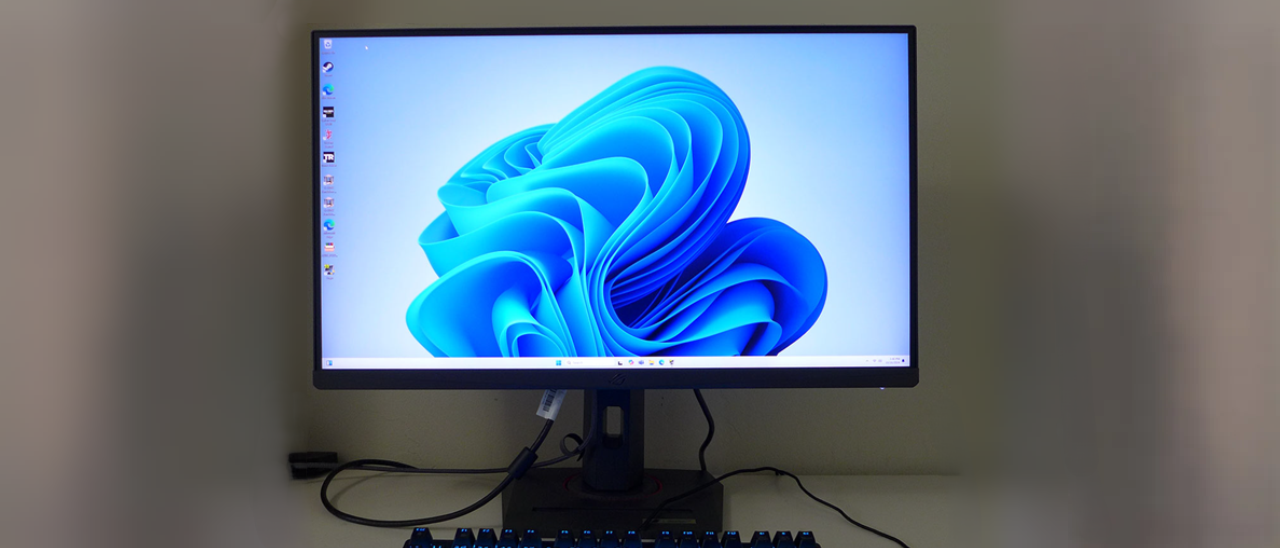Why you can trust Tom's Hardware
To compare the XG27UCS’s performance, I’ve rounded up a group of 4K screens in both 27 and 32-inch sizes. We have Cooler Master’s GP27U, BenQ’s EX321UX, AOC’s PD32M, Acer’s X32 and HP’s Omen 27k. They run at either 144 or 160 Hz.
Pixel Response and Input Lag
Click here to read up on our pixel response and input lag testing procedures.


One doesn’t typically buy a 4K gaming monitor for all-out speed, but the XG27UCS delivers on that count. Its 160 Hz refresh rate, if you can achieve it with your hardware, draws a full white field on the screen in 6ms. This alone would deliver reasonably smooth motion but not completely eliminate motion blur. The XG27UCS sets itself apart with a superb overdrive. There is almost no blur or artifacts when the overdrive is set to level 10. The traditional ELMB option is even smoother, erasing all signs of blur. Note that ELMB Sync also does this but with a significant reduction in brightness.
The XG27UCS does very well in the lag test with a 23ms score. This puts it on par with some QHD 240 Hz monitors. If quick control response is a priority for you, this monitor delivers.
Test Takeaway: For all-out competition, the XG27UCS might be a tad slower than the fastest 360 and 500 Hz monitors but its input lag isn’t far behind the best. 4K is not always the best way to achieve high frame rates, but the video processing here enables smoother operation than most UHD screens are capable of. ELMB Sync is a great way to have backlight strobing and Adaptive-Sync at the same time, something only a few other Asus monitors can do. But it sacrifices a lot of brightness in the process. My recommendation is to use traditional ELMB. That presents a super-smooth moving image, and the lack of AS isn’t a big deal if you can run 160fps. Bottom line: the XG27UCS has the best video processing and game performance in the LCD 4K category. Only a 240 Hz OLED will be smoother than this and you won’t be touching one of those for $460.
Viewing Angles
The XG27UCS’s off-axis image quality is solid when compared to other IPS monitors. The 45-degree side view shows a shift to red but no significant light output reduction. Gamma stays consistent so there is no loss of picture detail. The top view is better than most IPS panels can boast but still shows a 50% drop in brightness and a slight red/blue shift.
Screen Uniformity
To learn how we measure screen uniformity, click here.
Get Tom's Hardware's best news and in-depth reviews, straight to your inbox.
These are all high-end monitors so there is no shame in the XG27UCS’s last place finish. 8.45% is still comfortably below the visible threshold. My sample had no bleed or glow and color remained even-toned from edge to edge in test patterns and in all types of content.
MORE: Best Gaming Monitors
MORE: How We Test PC Monitors
MORE: How to Buy a PC Monitor
Current page: Response, Input Lag, Viewing Angles and Uniformity
Prev Page Features and Specifications Next Page Brightness and Contrast
Christian Eberle is a Contributing Editor for Tom's Hardware US. He's a veteran reviewer of A/V equipment, specializing in monitors. Christian began his obsession with tech when he built his first PC in 1991, a 286 running DOS 3.0 at a blazing 12MHz. In 2006, he undertook training from the Imaging Science Foundation in video calibration and testing and thus started a passion for precise imaging that persists to this day. He is also a professional musician with a degree from the New England Conservatory as a classical bassoonist which he used to good effect as a performer with the West Point Army Band from 1987 to 2013. He enjoys watching movies and listening to high-end audio in his custom-built home theater and can be seen riding trails near his home on a race-ready ICE VTX recumbent trike. Christian enjoys the endless summer in Florida where he lives with his wife and Chihuahua and plays with orchestras around the state.
-
truerock I just can't understand why somebody would want to put crummy, low-quality speakers inside of their monitor. It just seems like the strangest idea. They like having a monitor that vibrates?Reply
Wouldn't it be better to have good speakers? -
Sluggotg Reply
I use Nice Speakers or a Good Headset for most of my computing activities. When I am building, fixing/trouble shooting, updating, testing, etc., I use a monitor with built in speakers. Less hassle, less clutter at my computer work desk.truerock said:I just can't understand why somebody would want to put crummy, low-quality speakers inside of their monitor. It just seems like the strangest idea. They like having a monitor that vibrates?
Wouldn't it be better to have good speakers? -
Syntaximus Just picked one of these up for $370 on Amazon, totally worth it.Reply
The color accuracy out of the box is on point exactly as the review says.
I haven't even bothered trying to calibrate it yet, just adjust the brightness as needed.
No dead pixels, hardly any glow/bleed, just as perceivably snappy as my old TN.
Colors and viewing angles are great, contrast is meh, but that's IPS, and for the price I don't mind.
No issues w ghosting either so far on the #10 setting, but will probably need adjusting if tanking FPS.


